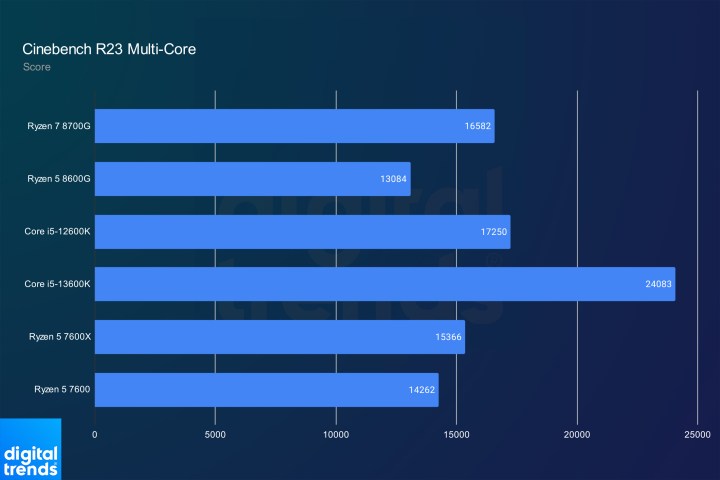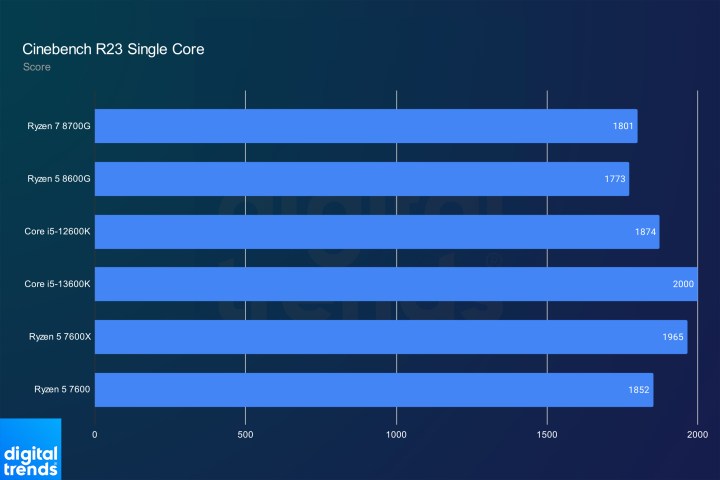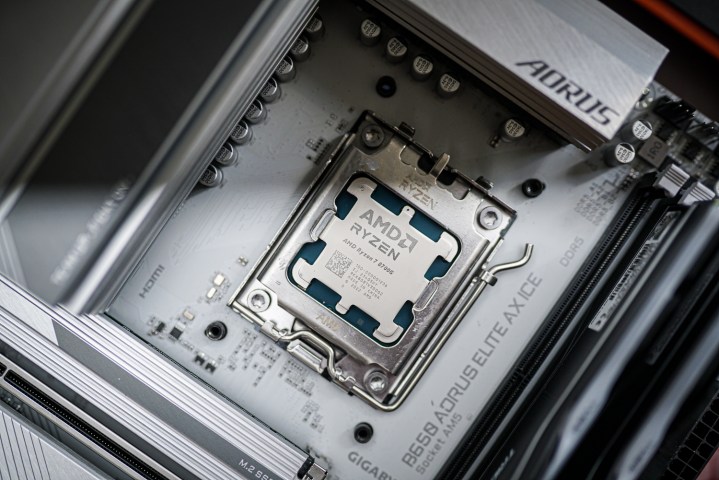
I could barely contain my excitement when AMD announced its Ryzen 8000G APUs. It was a return to form, offering the latest in AMD’s CPU and GPU architectures in a single package for a low price. More than that, there was hope that these would be the first APUs to allow for some serious PC gaming without the need to spend loads of cash on one of the best graphics cards.
But after testing them and looking at the other options, I’m not convinced this is the best starting point for aspiring PC gamers.
The graphics prowess you’ll find in one of these chips is leaps and bounds ahead of the typical integrated graphics you’d find among the best CPUs, even in a chart-topping chip like Intel’s Core i9-14900K. Unfortunately, these APUs struggle to meet the demands of modern games, and the trade-off is rarely justified when you can build a much more powerful gaming PC for the same price.
CPU power
Let’s look at these as CPUs first, though. I tested two chips: the six-core Ryzen 5 8600G and the eight-core Ryzen 7 8700G. Think of these different versions of AMD’s Ryzen 5 7600 and Ryzen 7 7700. The specs are slightly different, with some shifting of clock speed and cache counts to account for the integrated graphics, but you’re getting the same number of Zen 4 CPU cores.
You can see in Cinebench R23 that these chips are similar. The Ryzen 5 8600G is slightly behind the Ryzen 5 7600 in both single and multicore performance, but that’s expected, considering some of the design caters to the integrated graphics.
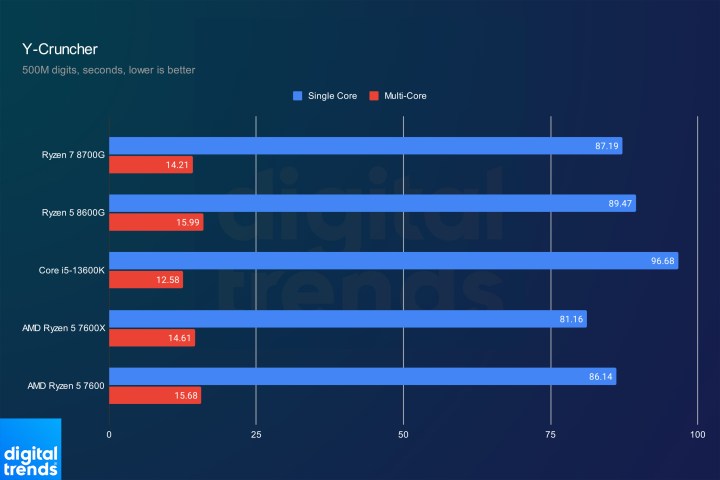
Basically, all of the benchmarks I ran came up with similar results. In Y-Cruncher, calculating 500 million digits of Pi, the 8600G and 8700G are slightly behind the base CPUs. This test shows that the single-core speed isn’t too bad, though. You can see both chips beating Intel’s Core i5-13600K in the single-core test.
The story doesn’t change much with Blender, 7-Zip, or Handbrake. As we typically see with APUs, the raw CPU performance is slightly behind that of a comparable chip due to the design with integrated graphics. There are some applications where the balance is much more even, such as Photoshop, where the integrated graphics can do wonders without a discrete GPU.
These aren’t bad just as CPUs, even if they aren’t quite as good as what you’d get with a chip that holds weaker integrated graphics. The big problem for these APUs isn’t the processors that cost around the same price. It’s those older chips like the Core i5-12600K or Ryzen 5 5600X that are readily available for very low prices. With one of those chips, you can get slightly worse CPU performance and allocate a whole lot of budget toward a discrete graphics card.
Staggering integrated graphics
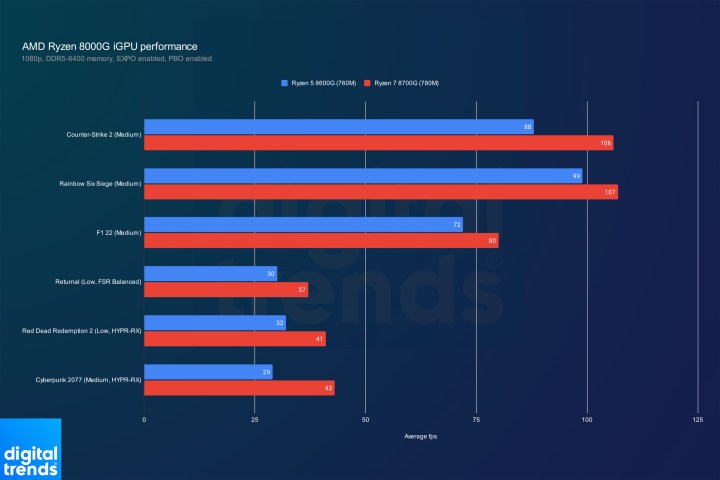
We need to shift gears to the integrated graphics because they’re the star of the show with these processors. The Ryzen 7 8700G holds AMD’s Radeon 780M, while the Ryzen 5 8600G has the Radeon 7600M. Both are based on the RDNA 3 architecture — found in GPUs like AMD’s RX 7600 XT — with 12 and eight Compute Units (CUs), respectively.
I tested six games with just the integrated graphics, leaning heavily on AMD’s one-click HYPR-RX feature in more demanding games like Cyberpunk 2077 and Red Dead Redemption 2. Supported games handle the settings differently, so this sometimes enables upscaling with FidelityFX Super Resolution (FSR), such as in Cyberpunk 2077, while other times the game runs at native resolution, such as Red Dead Redemption 2.
| Ryzen 7 8700G | Ryzen 5 8600G | |
| Cores/threads | 8/16 | 6/12 |
| Base/max frequency | 4.2GHz/5.1GHz | 3.5GHz/5GHz |
| Cache | 24MB | 22MB |
| Architecture | Zen 4 | Zen 4 |
| TDP | 65W | 65W |
| Graphics | Radeon 780M | Radeon 760M |
| Price | $330 | $230 |
The goal here isn’t a scientific comparison but rather an accurate representation of how you might actually use these APUs. In less-demanding esports titles like Counter-Strike 2, Rainbow Six Siege, and even F1 22, you’re getting smooth frame rates at medium settings. It’s closer to the 30 frames per second (fps) line for more demanding titles, even with medium to low settings.
There are some ways to boost performance further, either with more aggressive upscaling modes or faster memory (more on that next), but the performance window is fairly narrow. APUs can barely get over the line of playable with upscaling and low graphics settings already, so you don’t have a ton of options to improve your performance beyond what you see here, even if you take a massive hit to visual quality.
The idea behind an APU isn’t that it will be your final destination for gaming. They’re a stepping stone, allowing you to dip your toe in the PC gaming waters while you save up some money to invest in a discrete GPU. Drop one in, and you’re off to the races. The problem for AMD with Ryzen 8000G right now is that the math doesn’t really favor starting with an APU.
The price dilemma

You’ll need to spend $230 for the Ryzen 5 8600G and $330 for the Ryzen 7 8700G. Those are great prices, but once you factor in the cost of a full build, you can actually build a PC with a discrete graphics card for around the same price. And you don’t need to sacrifice that much in the process.
I put together a list with AMD’s Radeon RX 6600, which can clear the bar of 60 fps gaming at 1080p with maxed-out settings, and that’s without upscaling. Inside a build with a last-gen Ryzen 5 5600X, 16GB of DDR4, and 1TB of storage, the total cost comes out to about $700.
If you transfer the same parts list over, swap out the motherboard, RAM, and CPU, and take out the graphics card, you come to the exact same $700 price with the Ryzen 5 8600G. You can take the build in different directions, too, opting for something like the Intel Core i5-12600K, which is around $150 at the time of writing, or spending an extra $100 for a nicer GPU or a platform based around DDR5 memory.
I don’t want to pretend like these builds are directly comparable. Going with a new Ryzen 8000G CPUs grants you access to newer DDR5 memory, the AM5 platform that AMD says it will support through 2025, and a dedicated AI processor that’s not available on older Ryzen CPUs. There’s a lot of value in these new chips, but there’s a balance of priorities for aspiring PC gamers.
If PC gaming is your main priority, you can get a much better gaming experience for around the same price. You’ll need to upgrade your PC eventually, but you’ll need to do that even with a Ryzen 8000G CPU. And, in some cases, you’ll actually spend more on a build with a Ryzen 8000G APU for parts that may not hold their value as you upgrade your PC.
The problem with APUs in 2024
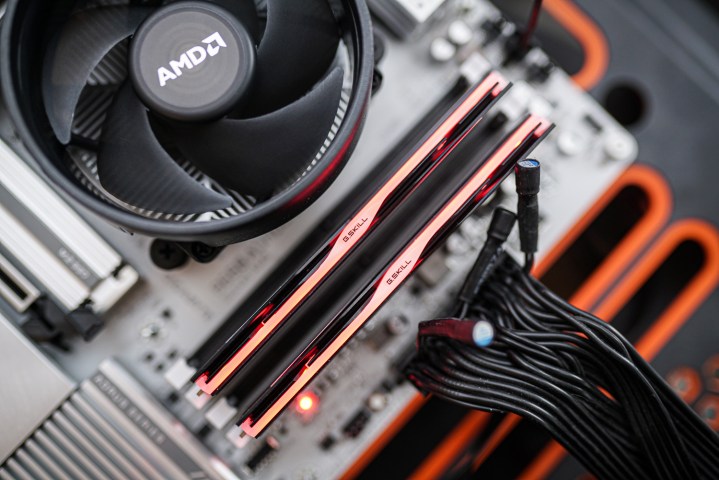
The main crux of the problem with APUs in 2024 is memory. A discrete GPU has its own dedicated memory, known as VRAM, that’s positioned around the processing unit inside your graphics card. That’s not how APUs work. APUs borrow from your system memory or RAM. There’s a bit of extra cache on the chip itself, but by and large, your system memory serves as the “VRAM” for the integrated graphics.
That presents two issues. First, you’ll need at least 16GB of memory with one of these Ryzen 8000G CPUs, according to AMD, and you’d likely benefit from 32GB. In addition, you want fast memory. Latency and memory speed are extremely important for an APU, so faster DDR5 memory can make a sizeable difference in performance.
With a discrete GPU, faster memory can improve gaming performance, but more often than not, it barely moves the needle. Considering the still high cost of DDR5 memory, you’ll sometimes spend an extra $50 on a high-capacity, speedy kit to pair with an APU rather than the cheaper DDR5 or older DDR4 memory you can still find.
High speed and high capacity are important for modern games. Nearly every title I launched as part of my benchmarking process warned me of insufficient video memory, and in a time when even 8GB GPUs are being criticized for issues in games, it might be time to reconsider where an APU lands.

None of this is to say AMD’s Ryzen 8000G APUs are bad. They’re fast enough when it comes to raw CPU performance, and the performance of the integrated graphics is astounding. But, for those primarily concerned with starting off in the world of PC gaming, you can get much better performance for the same money.
The role of Ryzen 8000G CPUs isn’t a stepping stone for PC gaming in 2024, at least in my mind. These chips particularly shine for those who aren’t really interested in gaming but still want a little graphics horsepower for the occasional esports title. I suspect they’ll look a lot more impressive in the future, too, with not only sales changing the value proposition, but also the cost of an AM5 motherboard and kit of speedy DDR5 memory coming down.

